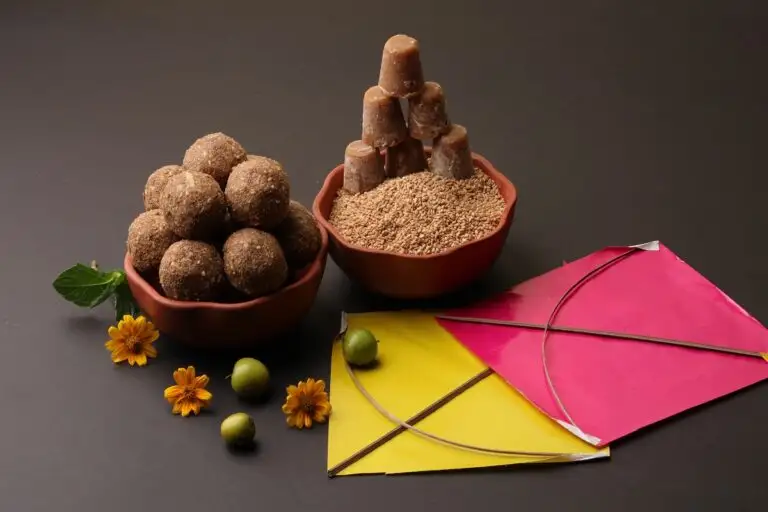Celebrated on 14th of January, Makar Sankranti is the harvest festival that is marked by sun’s shift in position. Around the 14th January , the sun enters Capricorn ( Makar in Hindi and Sanskrit ) and starts on its Northward journey, a transition called Uttarayan in Sanskrit. This is the harvest time of the year. Lohri in Punjab, Pongal in Tamil Nadu and Bhogali Bihu in Assam , are all harvest festival that mark the significant shift in season that happens around this time. These festivals have the same significance, as all these festivals are related to harvest of crops in almost all the states of India as the theme of UNITY IN DIVERSITY reverberates throughout the country. These festivals have common specialities like tradition, good food and pray to the Sun God with the offerings of til seeds.
If Diwali is incomplete without Kaju barfi, then no Makar Sankranti celebrations are ever complete without its round of til (sesame) and gur (jaggery) delicacies. Sesame or til seeds holds special significance during Makar sankranti is revered as the grain par excellence and is eaten and given away in Daan. As per Hindu mythology the God Yama blessed the sesame seed and hence they are regarded as the symbol of immortality.
“Tilgul ghya ani god god bola”, is a common expression used to greet family and guests in Marathi households during Sankranti celebrations. It literally means “eat til and gul and speak well”. But the humble tilgul can do more than just make you speak sweetly.
There is a scientific reason behind consuming sesame and jiggery on Makar Sankranti. In winter, when the body needs heat, then these sesame and jaggery sweets work well to provide heat and energy. There longer shelf life makes it possible to store the snacks for a long period of time. Since time immemorial both of these have played their significant role.
Tilgul sweets are made by adding roasted sesame seeds and coarsely chopped peanuts to molten jiggery. The mixture is then molded into desired shapes. The result is a delicious sweetmeat that has the salty sweetness of the jiggery and the nuttiness of the nuts and seeds. But apart from the great taste, tilgul is also a great health food perfect for the cold weather.
Sesame seeds (Til) – is a nutritious oilseed, often known as the ‘queen of oilseeds”, since it doesn’t get oxidized easily. They contain50-6-% high quality oil, which is rich in polyunsaturated fatty acids. Studies show that it helps reduce LDL cholesterol and triglycerides and is good for heart health. It is high in proteins, Vitamin B1, dietary fiber, iron, phosphorus, calcium, manganese, copper and zinc. It also has a high level of bioactive components that offer a lot of health benefits. They strengthen bones, boost hair quality, control blood sugar and keep skin healthy. It contains rich reserves of antioxidants. Sesame is considered as a heat inducing food. As it is rich in dietary fiber, it helps to improve digestion.
Jaggery (Gur)- is a nutritious sweetener considered healthier than regular processed sugar. It’s made from sugarcane juice, date or palm sap and has a golden brown colour. It’s mostly made of sucrose, and is rich in micronutrients such as potassium, magnesium, iron, and manganese, it’s also a good source of Vitamin B. it activates digestive enzymes which makes the process easier. It is rich in iron which purifies blood, while minerals like zinc and selenium prevent early ageing. It has anti allergic properties and prevents respiratory problems.
Eating a combination of both of these is a great way to replenish energy when you feel sluggish. In short tilgul is a great food to have during winter months. It gives warmth to your body and keeps you healthy. It has so much to offer than just its nutty taste. But since it’s a sweet treat, people with Diabetes should be wary of going overboard.
So what are you waiting for? Collect some til along with gul and make scrumptious sweets for you and your family…Here’s to the spring that awaits, to the colourful kites and all the lovely festive treats. Here’s wishing you all a Happy Makar Sankranti.
By
Mrs.Swati Awasthi
Head Dietician


















